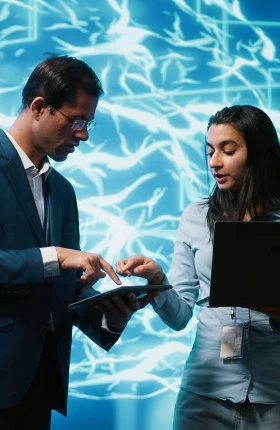This article and the accompanying slide deck are part of a series exploring how companies in specific industries can adopt the mindset, expertise, and ambition required to win in an AI-first world.
For consumer products (CP) companies, AI is not optional. It’s already everywhere around them.
About 20% of decisions in the typical consumer’s journey are influenced by large language models. AI agents are redefining how consumers discover, evaluate, and purchase products.
Retailers are investing heavily in AI in merchandizing, procurement, pricing, and promotion. CP companies need to invest to keep up with these customers.
Increasingly, the leaders in CP will be AI-first companies—putting AI at their core—because the benefits are so material.
AI-First Will Define the Future
What will an AI-first CP company look like?
- Faster. Companies will have access to real-time consumer sentiment analysis, derived from first-party and other data, that will automatically shape marketing strategies. Innovation cycles will shrink from years to months.
- More Relevant. Companies will engage with their customers directly through digital-first selling models, AI agents, and tailored experiences with dynamic pricing and promos.
- More Innovative. Companies will be able to zero in on the ideas most likely to succeed through consumer insight and AI-based simulation.
- More Resilient. Companies will be able to dynamically adjust commercial investments, pricing, inventory, and capacity.
- Leaner. Productivity gains of 30% to 50% will enable employees to focus on strategic work and unlock resources for new AI-native roles.
AI is already starting to alter the foundational economics and structures of CP firms. By harnessing AI, companies can unlock up to 500 to 800 basis points of financial value. They can then reallocate these savings to brand building, consumer access, and technology investments. As part of this transformation, companies will likely spend less in aggregate on people (but more on a per-employee basis). Multiskilled, integrated teams combining human expertise and AI agents will be the norm, allowing for faster decision making and superior execution.
Stay ahead with BCG insights on the consumer products industry
How Leaders Are Becoming AI-First
This all-encompassing aspiration to become AI first will be challenging for many global CP companies in the short run. These matrixed organizations cannot simply be torn down and built anew.
But they can start by taking the more manageable steps laid out in BCG’s deploy-reshape-invent framework. Deploy focuses on productivity gains, such as through the automation of media analytics or content creation. Reshape aims at transforming workflows, and invent creates entirely new business models.
For most global CP companies, more than 90% of the initial value of AI will come primarily by reshaping and then gradually shifting to inventing. Here are three examples of reshaping:
- A global CP company is significantly streamlining its organization with AI. It is targeting a 200-basis-point reduction in SG&A expenses by deploying swarms of AI agents across core processes in marketing, R&D, sales, and supply chain. The transformation is improving efficiency by 40%, speeding concept development by a factor of three, and improving the quality of outcomes by 30%.
- A CP leader uses AI to maximize marketing ROI and to accelerate its end-to-end innovation cycle. It is already seeing a 15% improvement in marketing ROI through automated content generation, predictive modeling, and simulation. It is also saving months in its development cycle by automating repetitive tasks.
- A global beverage company has created an AI-first commercial decision-making approach for marketing, revenue management, and sales force deployment. It has lifted EBIT across these initiatives by 300 basis points.
Leaders are also starting to move into the invent phase by creating new business models and approaches, such as L’Oréal’s Beauty Genius. This AI-powered chat assistant allows consumers to virtually try on beauty treatments and provides round-the-clock personalized beauty recommendations.
Such innovations enhance customer engagement, sharpen competitive advantages, and create new revenue streams.
How to Start
To start on this journey, companies can develop a set of practices that will help prepare them for the fast-approaching AI-first world:
- Refocus strategic priorities. Define what you’re solving for, which competitive advantages to strengthen, and which consumer and customer shifts to anticipate.
- Focus governance, resourcing, business, and technology efforts. At the same time, preserve space for bottom-up innovation and experimentation.
- Create an agile tech strategy. Retain the flexibility to work with a range of tech partners and decouple AI efforts from existing backbone modernization.
- Set up a focused AI delivery office. Anchor the AI program in a central delivery team connected to transformation and finance.
- Anticipate medium-term impacts. Plan for changes to organizational design, talent strategy, and competitive dynamics as AI scales.
- Drive cultural change. Shape new behaviors and mindsets through leadership modeling and organization-wide upskilling.
Leaders can do more than set an example. They can push the organization’s ambitions away from the now to the near-and-next opportunities to reshape and invent. And they can focus organizational momentum on a few choice strategic bets rather than a portfolio of speculative ones. In doing so, they will lead their organizations into an AI-first future.







